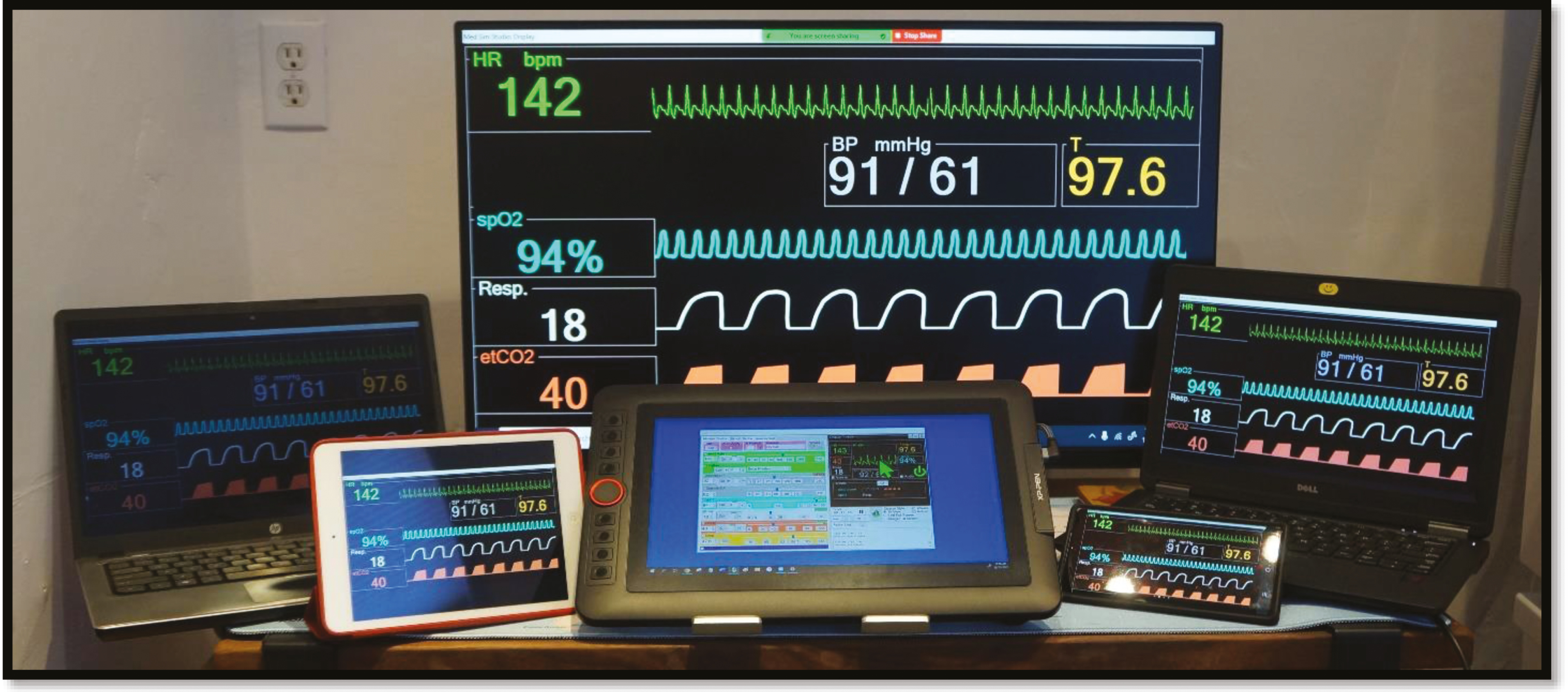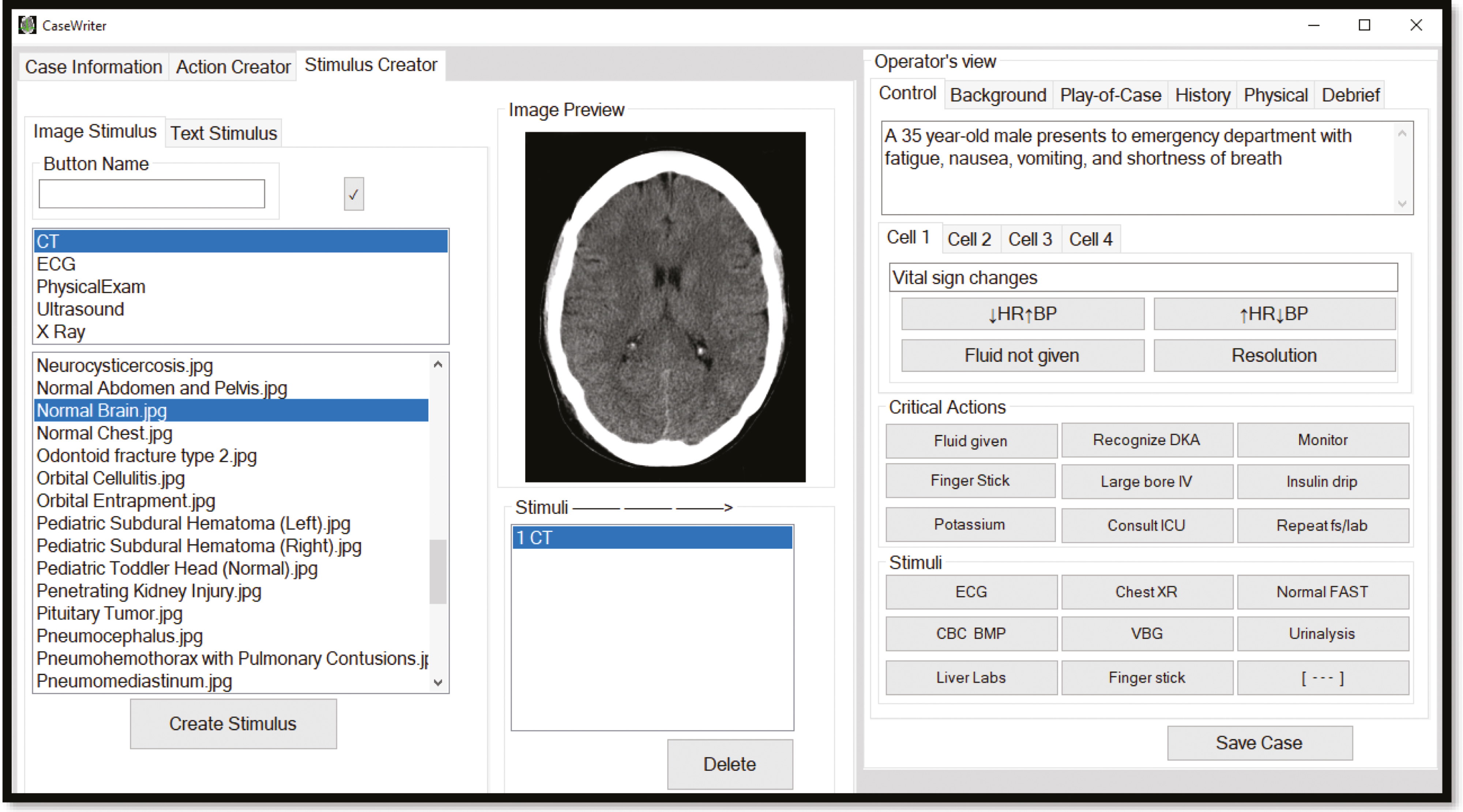
Medical simulation as an educational modality requires equipment, medically trained educators and software to improve the knowledge, skills and attitudes of learners [1]. Simulation software is particularly important to the practice of simulation education because the real-time display of vital signs and medical images enhances the learner’s sense of ‘being there’ and psychological fidelity [2]. Commercial software platforms are often cost-prohibitive, license-protected, and may not incorporate simulation case packages into their content. In order to circumvent these obstacles to education, the Free Open-Access Medical Education (FOAMED) movement provides education dissemination infrastructure for educators to more easily share their contributions [3].
The software innovation Med Sim Studio (www.MedSimStudio.com) is a free-to-use non-commercial software application designed to provide simulation educators with all the software needs they need to teach, display medical waveforms and stimulus images, author and share cases and evaluate learners [4]. Med Sim Studio offers a no-cost alternative to commercial platforms with a comparable feature set. Med Sim Studio is compatible with remote learning platforms, in situ simulation, simulation labs and small group environments (Figure 1).


Med Sim Studio may be shared via ‘screen share’ on multiple devices simultaneously, allowing for education via remote learning, in situ simulation, small groups and the simulation laboratory.
Med Sim Studio was developed by the author of this article, Adam Blumenberg, MD, MA, over 2 years. The technical development, including description of the software codebase, is described by Blumenberg and Kessler [4]. The software development utilized a needs assessment of simulation educators, resident educators, residents and students. This was followed by an iterative improvements and user-centred design process, which lead to deployment of 1–5 monthly software updates and feedback-improvement cycles [5].
At the conclusion of the development process, Med Sim Studio was released on a globally accessible website and downloaded hundreds of times by various users. The final release of the software platform includes a fully functioning vital sign simulator including waveforms (electrocardiography, oximetry, capnography, arterial blood pressure monitoring and ventilator flow), over 300 high-resolution medical images (radiographs, CT scans, video ultrasounds, physical exam findings), laboratory values, sound effects, evaluation tools and the ability to author and share cases.
The most unique aspect of Med Sim Studio is the ability for educators to run, author and share pre-scripted cases (Figure 2). There are over 20 simulation cases that are pre-packaged with the software at initial run time. Additionally, users may author their own custom cases as well as share them via a centralized online database, e-mail or other digital media functionality. Cases include everything a simulation educator requires to run the case including pre-scripted vital signs and stimulus images, background information, play-of-case, patient history, physical examination and a debrief plan. The core software is packaged with over 20 cases and users may easily share their own cases with the simulation community.


Med Sim Studio allows authors to develop customized cases which include everything a simulation educator requires to teach: pre-scripted vital signs, embedded stimulus images and laboratory values, critical action tracking and case information (background, play-of-case, history, physical and a debrief guide). Cases can be shared from user to user easily via a centralized database, or sent through e-mail or portable digital media.
Med Sim Studio has been evaluated by several end-users and organizations. The software contains an optional anonymized data reporting system, and number of downloads are tracked by the website server. Additionally, several individuals and organizations have taken an interest in Med Sim Studio and communicated with the developer directly. Furthermore, large simulation organizations have independently written weblog posts about Med Sim Studio, and the software has received awards.
Med Sim Studio has been downloaded over 500 times and 377 users have run cases five or more times. Users from India, Germany, the USA, Italy, Austria, Egypt, Switzerland, Australia and Brazil have initiated contact with the developer asking about the software, indicating an international userbase. Additionally, the software has been featured on multiple blogs including www.SimZine.it, www.ImpactsCollaborative.com, www.HealthySimulation.com and www.LowCostSim.Wordpress.com. The software developer also received the ‘Innovator of the Year’ award by the Society for Simulation in Healthcare in 2023 presented at the International Meeting for Simulation in Healthcare.
The numeric usage data as well as qualitative feedback indicate that simulation educators have significant usage and engagement with Med Sim Studio in multiple countries. Med Sim Studio is utilized as a resource by simulation educators globally.
Additional research will examine exactly how and where Med Sim Studio is used. For example, while the software may be used in multiple environments research could focus on whether Med Sim Studio allows for expansion of medical simulation through accessibility. Since the software platform is mobile and may be utilized with a laptop and battery-powered monitor, Med Sim Studio could potentially be used in non-traditional simulation environments such as an ambulance or in the field. Additionally, since the software reduces many of the barriers to simulation education it would be helpful to study to what extent Med Sim Studio allows for more frequent simulation education in the hospital and classroom environment.
None declared.
None declared.
None declared.
None declared.
None declared.
1.
2.
3.
4.
5.